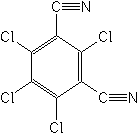| Common
Name: |
Chlorothalonil
|
| Chemical
Name: |
2,4,5,6-tetrachloro-1,3-benzenedicarbonitrile
|
| CAS
No.: |
1897-45-6
|
| Structure: |
 |
| Molecular
Formula: |
C8Cl4N2
|
| Molecular
Weight: |
265.9
|
| Physical
Chemistry: |
Technical product is a grayish to colorless crystalline solid that is odorless to slightly pungent. Solubility: 0.6 mg/L
in water;Solubility in Other Solvents: acetone s.s.; dimethyl sulfoxide s.s.; cyclohexanone s.s.; kerosene i.s.; xylene s.s. Melting
Point: 250-251C.Vapor Pressure: 1.3 mPa @ 40 C.
|
| Toxicity: |
The oral LD50 is greater than 10,000 mg/kg in rats and 6000 mg/kg in mice. The acute dermal LD50 in both albino rabbits and albino rats is 10,000 mg/kg. In albino rabbits, 3 mg of chlorothalonil applied to the eyes caused mild irritation that subsided within 7 days of exposure.Chlorothalonil is slightly toxic to mammals, but it can cause severe eye and skin irritation in certain formulations.
|
| Application: |
Chlorothalonil is a broad-spectrum organochlorine fungicide used to control fungi that threaten vegetables, trees, small fruits, turf, ornamentals, and other agricultural crops. It also controls fruit rots in cranberry bogs.
|
| Technical
Purity: |
97%Tech
|
| Formulation
Type: |
75%WP,72%SC,50%SC
| |



